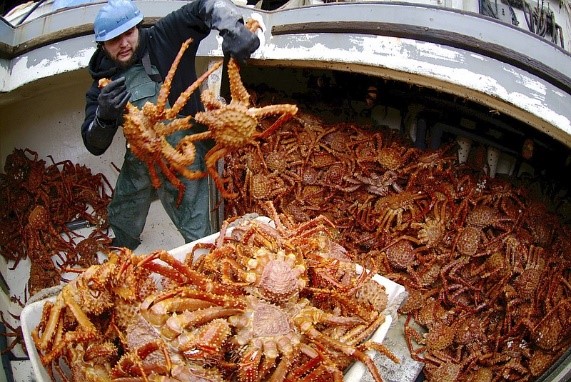PART 2
New science behind snow crab and Bristol Bay red king crab stock declines in Alaska came in 2022. The new research from scientists at the NOAA [National Oceanic and Atmospheric Administration] has found conclusively that climate change led to the demise of more than 10 billion snow crabs, with heatwaves in the Bering Sea leading to mass starvation of the creatures. The Alaska Department of Fish and Game and NOAA Fisheries work together to produce the Bristol Bay red king crab stock assessment in accordance with the co-management agreement outlined in the North Pacific Fishery Management Council’s Bering Sea/Aleutian Islands Crab Fishery Management Plan. They concur about the cause and are suggesting some partial solutions.
The harvest season of Bristol Bay red king crab was canceled because there were too few females. None of the crabbing closures will reopen until the catch reaches Alaska’s 200,000 pounds threshold. As in other adverse conditions on the Earth, climate change will continue to present challenges to the understanding of marine ecosystems in Alaska and elsewhere; but we have a robust management system that will allow us to adapt as it has in past adverse environmental changes.
The scientists found that warmer temperatures and population density were significantly linked to higher mortality rates among mature crabs. This was a huge heat wave effect; temperatures around the Arctic warmed four times faster than the rest of the planet. There was maybe 4% of the coverage of ice that has historically been seen.
The scientific studies regarding what is happening with Alaska’s crabs is proof the climate crisis is rapidly accelerating and impacting livelihoods, the senior scientists said. And it came faster than expected by computer models. On the positive side, the scientists were optimistic in their conclusion about the crab mass death, and its implications. Thinking long term, the expectation is that the snow crab population will move north as the ice recedes and in the eastern Bering Sea, and we probably will not see as much of them anymore. Harvesting them will be an entirely different subject.
The scientists looked north of the Bering Sea, west toward Russian waters, and even into deeper levels of the oceans, and ultimately concluded that it was unlikely that the crabs moved, and that the mortality event is probably a big driver. The reason behind the mortality event is hungrier crabs. Snow crabs are cold-water species and found overwhelmingly in areas where water temperatures are below 2 degrees Celsius. Warmer ocean water was found to have wreaked havoc on the crabs’ metabolism and increased their caloric needs.
The amount of energy crabs needed from food in 2018–the first year of a two-year marine heat wave in the region–quadrupled compared to the previous year, researchers found. With the heat disrupting much of the Bering Sea’s food web, snow crabs had a hard time foraging for food and were not able to keep up with the caloric demand. Scientists believe that after the crabs starved to death and littered the ocean floor, large fish like the Pacific Cod scooped in and devoured the remains. That accounts for the lack of remains being discovered.
Retention of Tanner crab (C. bairdi) fishery has helped to sustain the market. Capture of Japanese spider crab is a large catch for any fisherman. With a leg span of 13 feet and an average weight of around 40 pounds, it has the deserved title of largest crab. It may also have the longest lifespan of any crab, living to be 100 years old. However, Japanese spider crabs do not survive very long without injury. Their long legs are weak, and a study found that three-quarters of surveyed crabs were missing at least one limb. To protect themselves from predation, the smaller and younger crabs can decorate their shells with objects such as kelp. They are not difficult to harvest, and it appears that they are reasonably plentiful; and it is likely that this giant will begin to replace the more familiar crab species on dinner plates soon.
Blue crabs are opportunistic omnivores. They will eat nearly anything they can find, including bivalves, dead fish, plant and animal detritus, and even other crabs! There is a similar blue crab death rate, but the causation is different in part. The question, “Why are blue crabs disappearing?” is related to habitat loss due to a decline in underwater grass abundance.
Like the snow crab deaths, that is due to warming waters, irregular weather patterns, and pollution, all of which have been linked to declines in the blue crab population.
For people who do not live in the Chesapeake Bay area, it may be reasonable to ask, “why are blue crabs important?”
The answers are multiple: As both predator and prey, blue crabs are a keystone species in the Chesapeake Bay food web. Blue crab larvae are part of the Bay’s planktonic community, serving as food for menhaden, oysters, and other filter feeders. Juvenile and adult blue crabs serve as food for fish, birds, and even other blue crabs. Striped bass, red drum, catfish and some sharks depend on blue crabs as part of their diet. Soft-shell crabs that have just molted are particularly vulnerable to predators as well as gourmet human food.
Blue crabs are among the top consumers of bottom-dwelling organisms, or benthos. They eat clams, mussels, oysters, smaller crustaceans, freshly dead fish, plant and animal detritus, and almost anything else they can find. Blue crabs feed on marsh periwinkles (snails), helping regulate periwinkle populations. Scientists are concerned that a decline in the Chesapeake Bay blue crab population could negatively affect salt marsh habitat, as periwinkle populations feed on marsh grasses. Blue crabs also support a large recreational fishery in the Bay and are the estuary’s most valuable commercial fishery. Over the past 60 years, blue crabs have dominated Chesapeake Bay fisheries, with an estimated one-third of the nation’s blue crab catch coming from the Bay. There are few things better than Chesapeake Bay blue soft shell crab sandwiches. By yearly Virginia and Maryland dredge counts, there are about 323 million blue crabs in the Chesapeake Bay, but that varies considerably year-to-year. That number is a 42% increase from 2022.
They are one of the perfect foods in this man’s book: sweet crab meat held together with a soft, thin, edible shell. No more needs to be said.
Different from the snow crab problem is that the blue crab population has fluctuated over time in response to fishing pressure and environmental drivers including pollution and habitat loss. Striped bass, Atlantic croaker, red drum, and other predatory fishes feed on juvenile blue crabs. A significant change in abundance of these fish populations could affect the abundance of juvenile blue crabs, and consequently the future of the blue crab population.
Harvest is the primary source of blue crab mortality in the Chesapeake Bay. 36.3 million pounds of blue crabs were harvested from the Bay and its tributaries during the 2021 crabbing season. But environmental conditions including water quality, weather patterns and habitat also cause the abundance of blue crabs to fluctuate from year to year. Loss of habitat, particularly of underwater grasses and marshes, is among the primary concerns for the blue crab population in the Bay.
Water quality improvements, seagrass restoration and proper fishery management will help maintain this valuable resource as they have in the past.
Recipe for Snow crab fried rice on crab shellIngredients:
4 tablespoons oil, 2 tablespoons Ginger (minced), 2 cloves, 1 Garlic (minced), 4 cups White Rice (cooked), ¼ teaspoon White Pepper, 3 tablespoons Fish Sauce, 1 tablespoon Soy Sauce, 1 tablespoon Shaoxing Wine, add Salt, 2 Eggs (beaten), 1 cup Lump Crab Meat (cooked, half of a 16 oz. can/225g), 2 Scallions (chopped), ¼ cup Cilantro (chopped), add Lime Wedges.
Directions:
First, prep all of your ingredients, including your aromatics—ginger, garlic, cilantro, and scallions. Prep the beaten eggs as well and set them aside. Only when you have all the ingredients prepared and ready to go should you start cooking.
Heat the cooking oil in a wok over medium-high heat. Add the ginger first, stirring for 30 seconds. Then add the garlic. When the garlic is just cooked (before it starts to turn golden), add the cooked white rice to the wok, and turn up the heat to high. Stir fry the rice for 3 minutes or so until it’s thoroughly combined with the ginger/garlic mixture and/or warmed through if you’re using leftover rice.
Now for the flavorings: add the white pepper, fish sauce, soy sauce, and Shaoxing wine to the rice. If it’s not quite salty enough for you or if you know you won’t be eating it with added hot sauce, now is the time to add salt to taste. Stir-fry to combine. Using your wok spatula, spread the rice out into an even layer along the surface of the wok. Pour the beaten egg evenly over the rice.
Stir the rice until all the egg is cooked and incorporated. The egg coats the rice and makes for a most excellent savory experience. Much better than broken up bits/huge chunks of scrambled egg throughout.
Before adding the crab, use your wok spatula to once more spread the rice evenly in the wok. Add the crab to the rice and stir fry thoroughly.
When the crab is warmed through, add the scallion and cilantro and stir-fry briefly until the herbs are just wilted.
Serve your crab fried rice and finish with a squeeze of lime and your favorite chili oil.


